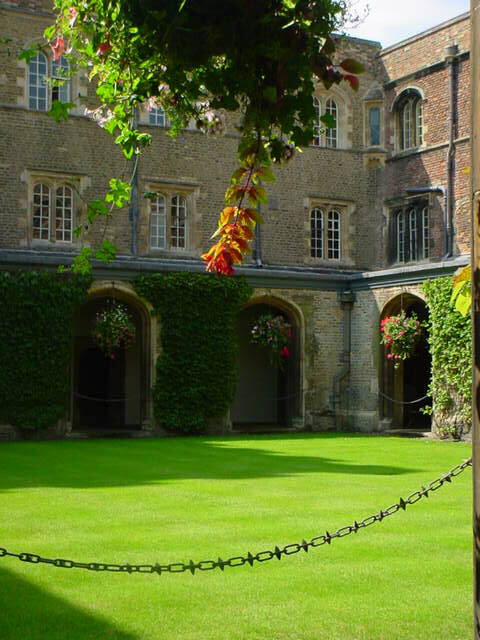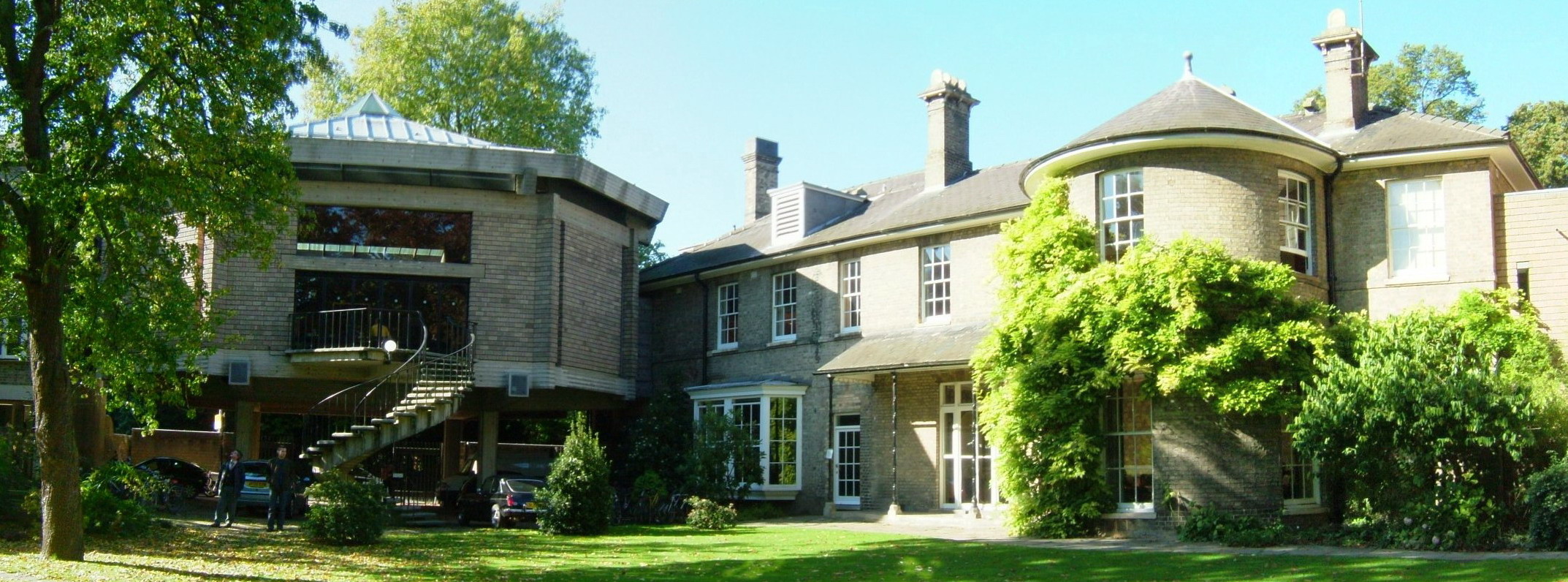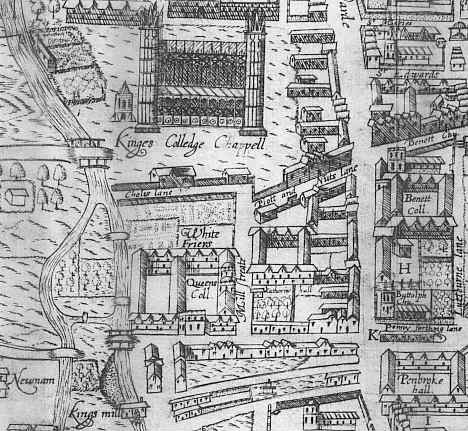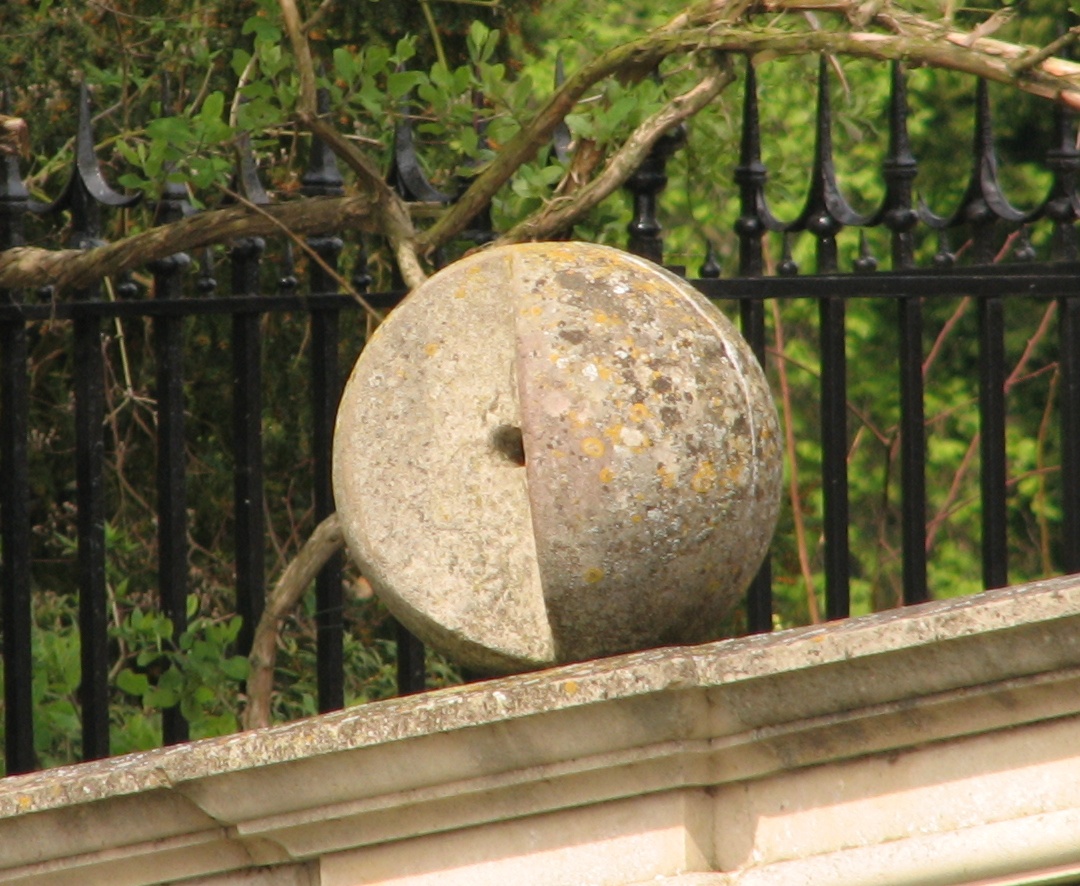|
The Backs
The Backs is a picturesque area to the east of Queen's Road in the city of Cambridge, England, where several colleges of the University of Cambridge back on to the River Cam with their grounds covering both banks of the river. In 2013, National Trust chairman Simon Jenkins included The Backs as one of his top ten views in England. The name The Backs refers to the colleges' backs. The region is made up of the following colleges' back grounds (from north to south): * St John's – buildings on both sides of the river, spanned by the St John's Kitchen Bridge and the Bridge of Sighs *Trinity – buildings on the east bank, spanned by Trinity College Bridge. * Trinity Hall – buildings on the east bank but with no rear grounds on the west bank. * Clare – buildings on the east bank, spanned by Clare Bridge. * King's – buildings on the east bank, spanned by King's Bridge. * Queens' – buildings on both sides of the river, spanned by the Mathematical Bridge. Sometim ... [...More Info...] [...Related Items...] OR: [Wikipedia] [Google] [Baidu] |
Trinity College, Cambridge
Trinity College is a Colleges of the University of Cambridge, constituent college of the University of Cambridge. Founded in 1546 by King Henry VIII, Trinity is one of the largest Cambridge colleges, with the largest financial endowment of any college at Oxford or Cambridge. Trinity has some of the most distinctive architecture in Cambridge with its Trinity Great Court, Great Court said to be the largest enclosed courtyard in Europe. Academically, Trinity performs exceptionally as measured by the Tompkins Table (the annual unofficial league table of Cambridge colleges), coming top from 2011 to 2017, and regaining the position in 2024. Members of Trinity have been awarded 34 Nobel Prizes out of the 121 received by members of the University of Cambridge (more than any other Oxford or Cambridge college). Members of the college have received four Fields Medals, one Turing Award and one Abel Prize. Trinity alumni include Francis Bacon, six British Prime Minister of the United Kingdo ... [...More Info...] [...Related Items...] OR: [Wikipedia] [Google] [Baidu] |
Jesus College, Cambridge
Jesus College is a Colleges of the University of Cambridge, constituent college of the University of Cambridge. Jesus College was established in 1496 on the site of the twelfth-century Benedictine nunnery of St Radegund's Priory, Cambridge, St Mary and St Radegund by John Alcock (bishop), John Alcock, then Bishop of Ely. The cockerel is the symbol of Jesus College, after the surname of its founder. For the 300 years from 1560 to 1860, Jesus College was primarily a training college for Church of England clergy. Jesus College has assets of approximately £375m making it Cambridge's fourth-wealthiest college. The college is known for its particularly expansive grounds which include its sporting fields and for its proximity to its Jesus College Boat Club (Cambridge), boathouse. Three members of Jesus College have each received a Nobel Prize. Two fellows of the college have been appointed to the International Court of Justice. Sonita Alleyne was elected master of Jesus College in 2 ... [...More Info...] [...Related Items...] OR: [Wikipedia] [Google] [Baidu] |
Silver Street, Cambridge
Silver Street is located in the southwest of central Cambridge, England.Silver Street , Cambridge City Council, England. It links Queen's Road, Cambridge, Queen's Road to the west with Trumpington Street to the east. The road continues west out of central Cambridge as Sidgwick Avenue. The road crosses the River Cam on Silver Street Bridge. The current bridge was built in 1958–1959 to a 1932 design by Sir Edwin Lutyens, and replaced an 1841 cast iron bridge. At the southwestern end to the south is Darwin College, Cambridge, Darwin College. Queens' College, Cambridge, Queens' College is halfway along on the north side, on both sides of the River Cam. At the eastern end to the north fronting onto Trumpington Street is St Catharine's College, Cambridge, St Catharine's College. To the north are The Backs along the r ... [...More Info...] [...Related Items...] OR: [Wikipedia] [Google] [Baidu] |
Darwin College, Cambridge
Darwin College is a Colleges of the University of Cambridge, constituent college of the University of Cambridge. Founded on 28 July 1964, Darwin was Cambridge University's first graduate-only college, and also the first to admit both men and women. The college is named after the family of Charles Darwin who previously owned some of the land, Newnham Grange, on which the college now stands. The college has between 650 and 800 students, mostly studying for Doctor of Philosophy, PhD or Master of Philosophy, MPhil degrees with strengths in the sciences, humanities, and law. Darwin is the largest graduate college of Cambridge. Darwin's sister college at Oxford University is Wolfson College, Oxford, Wolfson College. Members of Darwin College are termed ''Darwinians'' and alumni include British primatologist and anthropologist Jane Goodall, American conservationist Dian Fossey, Barbadian Governor-General Elliott Belgrave, Nobel Prize winner Elizabeth Blackburn, Nobel Prize winner Eric ... [...More Info...] [...Related Items...] OR: [Wikipedia] [Google] [Baidu] |
Magdalene Street Bridge
Magdalene Street is a street in the north of central Cambridge, England. It runs between Castle Street, by Castle Hill, at the junction with Northampton Street and Chesterton Lane, then Chesterton Road (the A1303), to the northwest and Bridge Street at the junction with Thompson's Lane to the southeast. The road straddles the River Cam on Magdalene Bridge (built 1823), just south of Magdalene College (hence the name) and just north of St John's College, one of the largest University of Cambridge colleges. Magdalene Bridge or the Great Bridge is on the site of the original bridge that gave 'Cambridge' its name. History Magdalene Street used to be the northwestern part of Bridge Street. It developed as the northern approach to the original river crossing for entering Cambridge. The first crossing was as a ford and this was built up as causeways by the Romans. Eventually a bridge was built across the Cam, giving Cambridge its name. The hilltop on the northwest bank h ... [...More Info...] [...Related Items...] OR: [Wikipedia] [Google] [Baidu] |
Magdalene College, Cambridge
Magdalene College ( ) is a constituent college of the University of Cambridge. The college was founded in 1428 as a Benedictine hostel, in time coming to be known as Buckingham College, before being refounded in 1542 as the College of St Mary Magdalene. Magdalene counted some of the most prominent men in the realm among its benefactors, including Britain's premier noble the Duke of Norfolk, the Duke of Buckingham and Lord Chief Justice Christopher Wray. Thomas Audley, Lord Chancellor under Henry VIII, was responsible for the refoundation of the college and also established its motto—''garde ta foy'' (Old French: "keep your faith"). Audley's successors in the mastership and as benefactors of the college were, however, prone to dire ends; several benefactors were arraigned at various stages on charges of high treason and executed. The college remains one of the smaller in the university, numbering around 400 undergraduate and 200 graduate students. It has maintained stron ... [...More Info...] [...Related Items...] OR: [Wikipedia] [Google] [Baidu] |
Mathematical Bridge
The Mathematical Bridge is a wooden footbridge in the southwest of central Cambridge, England. It bridges the River Cam about one hundred feet northwest of Silver Street Bridge and connects two parts of Queens' College. Its official name is simply the Wooden Bridge or Queens' Bridge. It is a Grade II listed building. The bridge was designed by William Etheridge, and built by James Essex in 1749. It has been rebuilt on two occasions, in 1866 and in 1905, but has kept the same overall design. Although it appears to be an arch, it is composed entirely of straight timbers built to an unusually sophisticated engineering design, hence the name. A replica of the bridge was built in 1923 near the Iffley Lock in Oxford. The original Mathematical Bridge was another bridge of the same design, also commissioned by James Essex, crossing the Cam between Trinity and Trinity Hall colleges, where Garret Hostel Bridge now stands. Mathematical explanation The arrangement of timbers is a ... [...More Info...] [...Related Items...] OR: [Wikipedia] [Google] [Baidu] |
Queens' College, Cambridge
Queens' College is a Colleges of the University of Cambridge, constituent college of the University of Cambridge. Queens' is one of the 16 "old colleges" of the university, and was founded in 1448 by Margaret of Anjou. Its buildings span the River Cam with the Mathematical Bridge and Silver Street connecting the two sides. College alumni include Desiderius Erasmus, who studied at the college during his trips to England between 1506 and 1515. Other notable alumni include author T. H. White, Israeli politician Abba Eban, founding father of Ghana William Ofori Atta, newsreader and journalist Emily Maitlis, actor and writer Stephen Fry, the Governor of the Bank of England Andrew Bailey (banker), Andrew Bailey, the British Member of Parliament (United Kingdom), members of Parliament Stephen Kinnock, Liz Kendall and Suella Braverman, and Fields Medallist James Maynard (mathematician), James Maynard. The college's first Nobel Prize winner is Demis Hassabis, Sir Demis Hassabis who rece ... [...More Info...] [...Related Items...] OR: [Wikipedia] [Google] [Baidu] |
King's College Bridge
King's College Bridge is the eighth river Cam bridge overall and the fourth bridge on its middle upstream in Cambridge. In the 15th century there was built the first wooden bridge, the current stone structure was designed by famous British architect William Wilkins in 1818 and it was constructed by Francis Braidwood in 1819. See also *List of bridges in Cambridge The following is a list and brief history of the bridges in Cambridge, England, principally those over the River Cam of which there are 26 (as of 2021). The River Cam enters Cambridge from the south west of the city and heads north past many of ... * Template:River Cam map References Bridges in Cambridge Bridges across the River Cam Pedestrian bridges in England Arch bridges in England King's College, Cambridge {{UK-bridge-struct-stub ... [...More Info...] [...Related Items...] OR: [Wikipedia] [Google] [Baidu] |
King's College, Cambridge
King's College, formally The King's College of Our Lady and Saint Nicholas in Cambridge, is a List of colleges of the University of Cambridge, constituent college of the University of Cambridge. The college lies beside the River Cam and faces out onto King's Parade in the centre of the city. King's was founded in 1441 by King Henry VI of England, Henry VI soon after founding its sister institution, Eton College. Initially, King's accepted only students from Eton College. However, the king's plans for King's College were disrupted by the Wars of the Roses and the resultant scarcity of funds, and then his eventual deposition. Little progress was made on the project until 1508, when King Henry VII of England, Henry VII began to take an interest in the college, probably as a political move to legitimise his new position. The building of the college's chapel began in 1446, and was finished in 1544 during the reign of Henry VIII. King's College Chapel, Cambridge, King's College Chap ... [...More Info...] [...Related Items...] OR: [Wikipedia] [Google] [Baidu] |
Clare College Bridge, Cambridge
Clare Bridge is the ninth bridge overall and the fifth River Cam bridge on its middle stream in Cambridge. The bridge now connects the Old Court of Clare College to Memorial Court, which was dedicated in 1926. It is a Grade I listed building. It is the oldest still-functioning bridge in Cambridge, built in 1639-40 by Thomas Grumbold (d.1659). It was restored in 1969. It is a three-span bridge in Early Renaissance style, built of Ketton stone ashlar. The balustrade has carved relief panels on the pedestals and is surmounted by ball finials. One of the fourteen stone balls has a missing section. Many different tales are told to explain the missing section of the globe second from the left on the south side of the bridge. The story most commonly cited by members of college is that the builder of the bridge was not paid the full amount for his work and so removed the segment to balance the shortfall in payment. A more likely explanation is that a wedge of stone cemented into the ball ... [...More Info...] [...Related Items...] OR: [Wikipedia] [Google] [Baidu] |









